
SPF DKIM DMARC Explained: The DNS Trio That Secures Your Emails
Email security is a major concern for individuals and businesses today, especially for email servers. With phishing, domain spoofing email spoofing, and fraud on the rise, it's crucial to ensure that emails are legitimate and secure. One of the best ways to protect email communication is through authentication protocols like SPF, DKIM, and DMARC. These three protocols, known as the "DNS Trio" work together to confirm that emails are authentic, preventing unauthorized users from impersonating legitimate senders.
Whether you're an IT professional, business owner, or email service providers, it's important to understand how SPF, DKIM, and DMARC function. These protocols help secure emails, boost deliverability, and guard against spoofing, which can damage your reputation and lead to serious security risks.
In this blog, we’ll explain what SPF, DKIM, and DMARC are, how they work, and why they’re crucial for securing your emails. We’ll also share tips on how to set them up for your domain and improve your email security strategy.
Understanding SPF, DKIM, and DMARC: The DNS Trio
SPF, DKIM, and DMARC are essential email security protocols that work together to authenticate and protect email messages. These protocols ensure that the emails you send and receive come from trusted sources, preventing attackers from impersonating your domain or tampering with your email content.
What is SPF, DKIM, and DMARC?
- SPF (Sender Policy Framework): SPF helps prevent email spoofing by allowing domain owners to specify which mail servers are authorized to send emails on their behalf. It checks if the sending server's IP matches the domain's SPF record. If it doesn’t match, the email is flagged as suspicious.
- DKIM (DomainKeys Identified Mail): DKIM adds a digital signature to the email’s header, created using a private key that only the sender’s server possesses. The recipient’s server can verify the signature with a public key stored in the domain’s DNS records, ensuring the email hasn’t been altered during transit and comes from the claimed domain.
- DMARC (Domain-based Message Authentication, Reporting & Conformance): DMARC builds on SPF and DKIM, allowing domain owners to specify how to handle emails that fail authentication (e.g., quarantine or reject them). It also provides reporting features, helping domain owners monitor and improve email security.
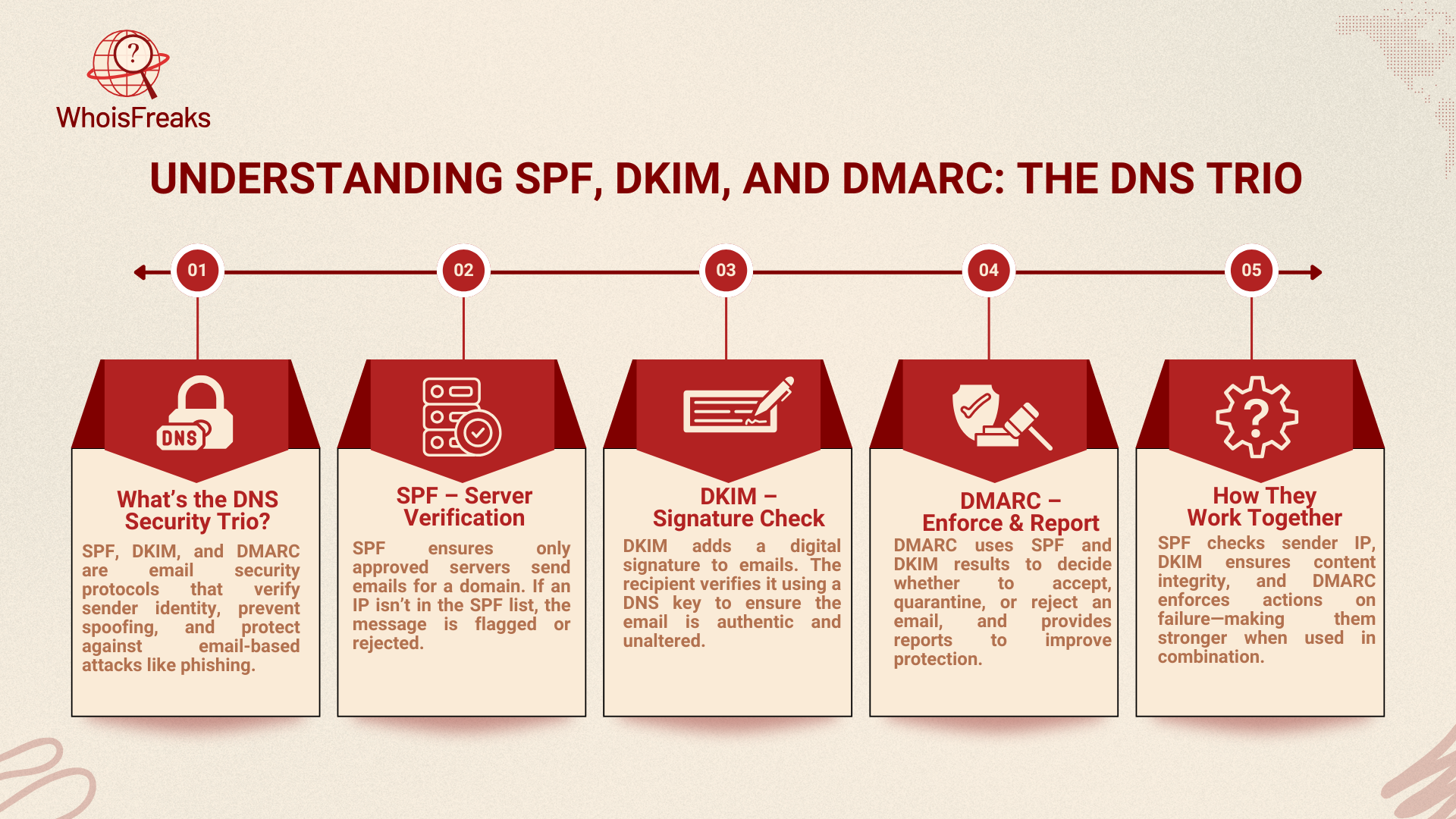
SPF (Sender Policy Framework): Verifying Mail Servers
The Sender Policy Framework (SPF) is an essential email authentication protocol that helps prevent email spoofing. It allows domain owners to specify which mail servers are authorized to send emails on their behalf, preventing unauthorized senders from impersonating your domain. This is crucial for protecting your brand and ensuring that legitimate emails reach their intended recipients.
What is SPF?
SPF is a protocol that validates the sender’s IP address by checking it against a domain’s SPF record, which is stored in DNS (Domain Name System). This record lists the mail servers that are authorized to send emails for the domain. When an email is sent, the receiving mail server checks the SPF record. If the sender's IP address matches one of the authorized addresses, the email is deemed legitimate. If not, the email is flagged as suspicious or rejected.
How SPF Works
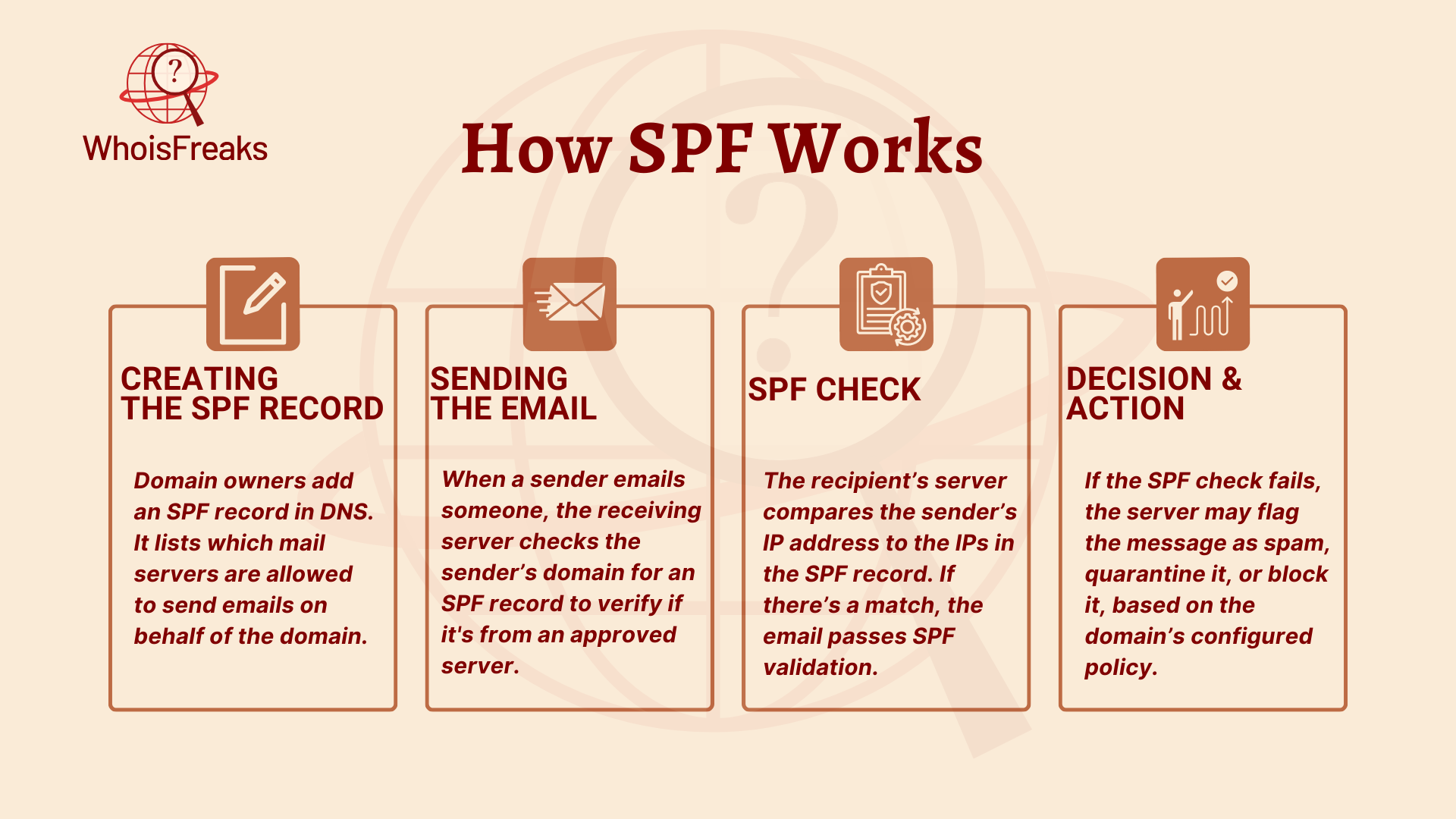
- Creating the SPF Record: Domain owners add an SPF record in their DNS settings, listing the authorized mail servers (IP addresses) that can send emails for the domain.
- Sending the Email: When an email is sent, the receiving mail server checks the SPF record for the sending domain.
- SPF Check: The receiving mail server compares the sending server’s IP address to those listed in the SPF record. If they match, the email passes the SPF check.
- Decision: If the email fails the SPF check (the sending server is not listed), the receiving server may mark it as spam, quarantine it, or reject it based on the domain’s policies.
Why SPF is Important for Email Security
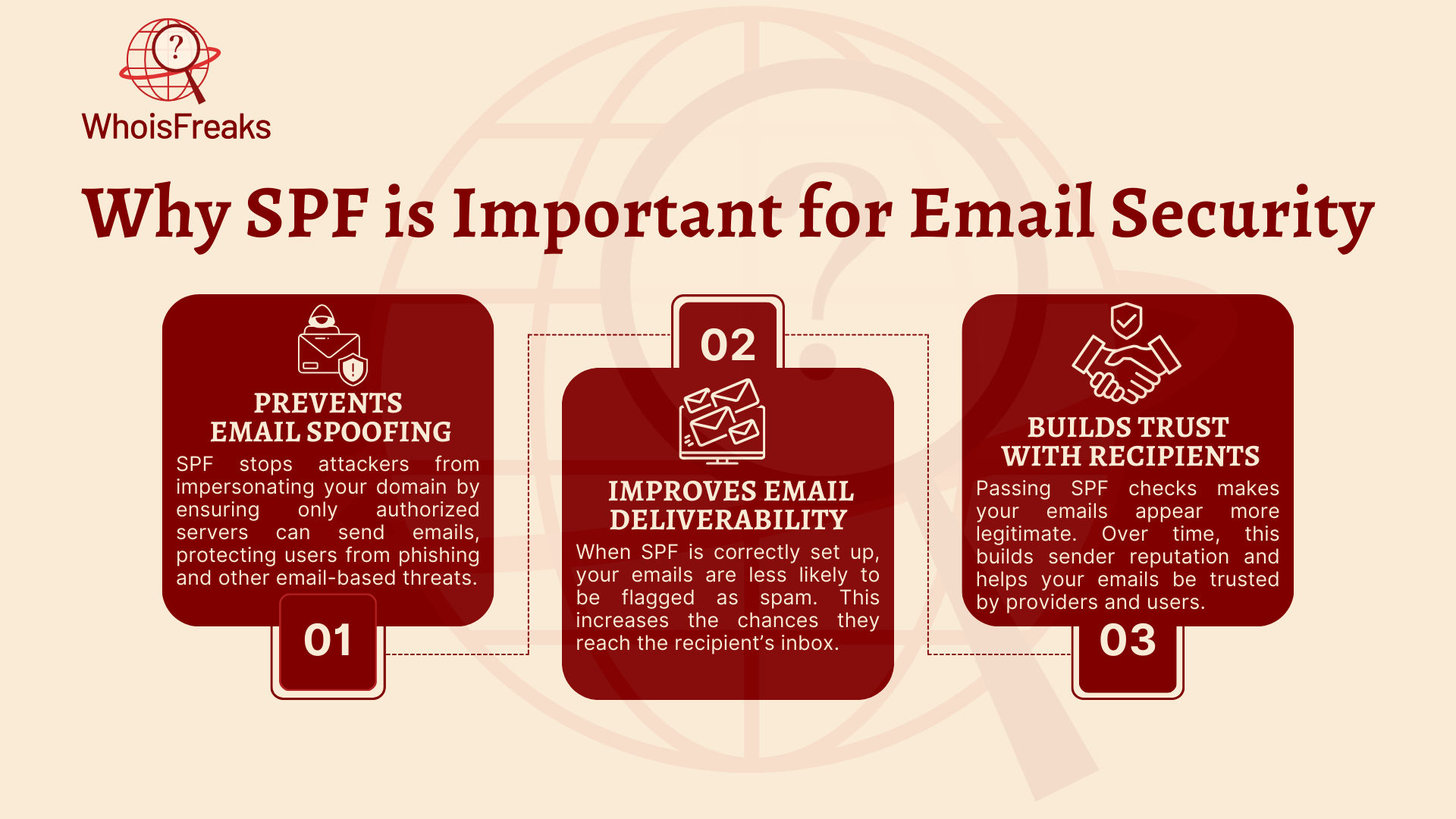
- Prevents Email Spoofing: SPF ensures only authorized servers can send emails for your domain, stopping attackers from impersonating your domain and sending fraudulent emails.
- Improves Email Deliverability: Proper SPF implementation increases the chances that your emails land in the inbox, not the spam folder, since email providers use SPF checks in their filtering process.
- Builds Trust with Recipients: Emails passing SPF checks are more likely to be trusted by recipients and email providers, improving deliverability and trust over time.
DKIM (DomainKeys Identified Mail): Ensuring Message Integrity
DomainKeys Identified Mail (DKIM) is another essential email authentication protocol that ensures both the integrity and authenticity of email messages. While SPF focuses on validating the sender's server, DKIM adds an extra layer of security with DKIM authentication by digitally signing emails. This digital signature confirms that the email content hasn’t been altered and that it truly came from the domain it claims to originate from.
What is DKIM?
DKIM works by attaching a unique digital signature to the email’s header. This signature is created using a private key that only the sender's mail server holds. When the email is received, the recipient’s mail server checks the DKIM signature against a public key stored in the domain's DNS records. If the public key matches, the email is deemed authentic and unaltered.
The DKIM signature contains the following information:
- Email Content: To ensure the message hasn’t been altered.
- Domain Name: To confirm the email is from the correct domain.
- Timestamp: To verify the message’s freshness.
How DKIM Works
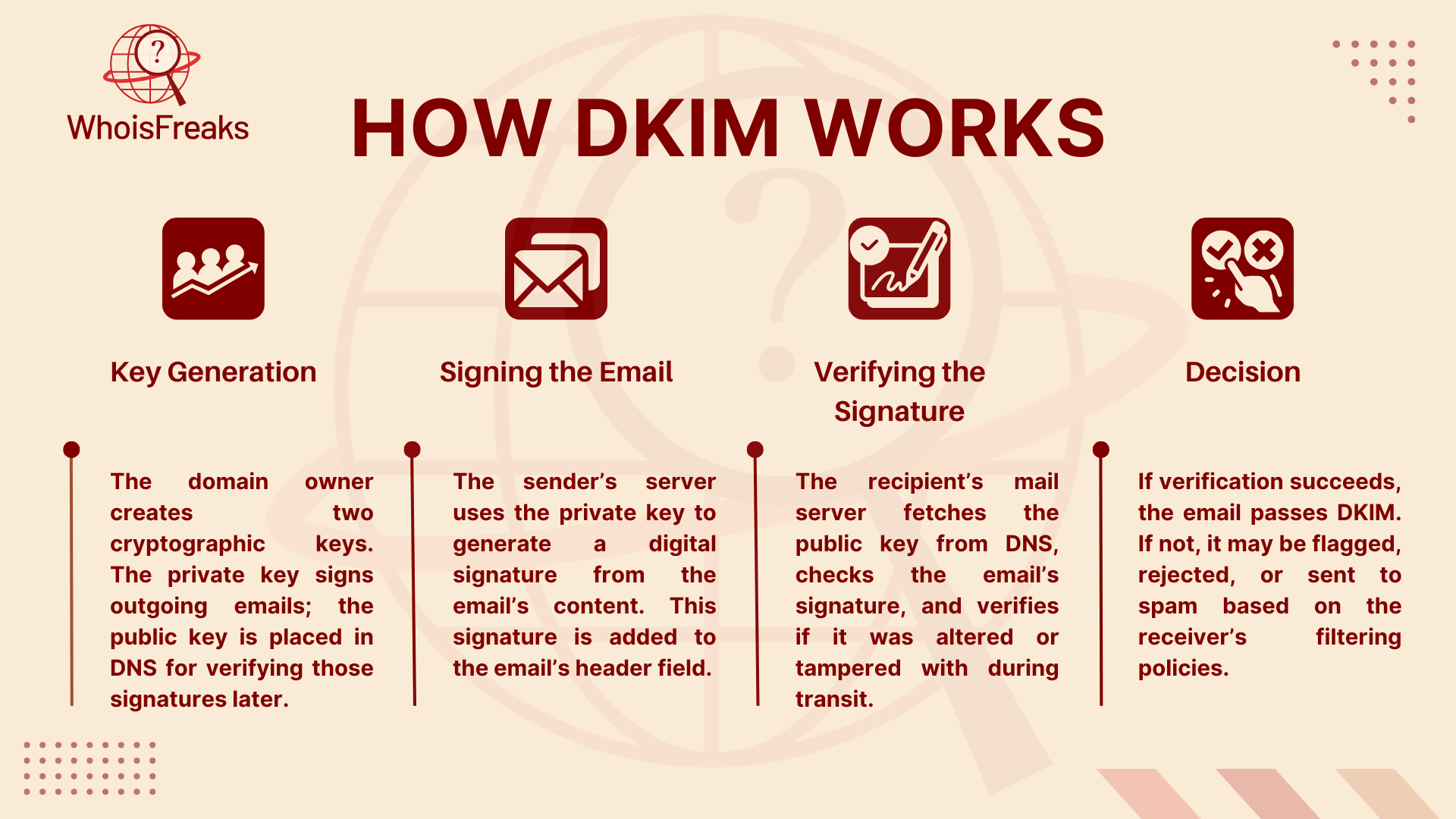
- Key Generation: The domain owner generates a pair of cryptographic keys: a private key (used by the sender to sign emails) and a public key (published in the domain's DNS record).
- Signing the Email: The sender's mail server uses the private key to create a digital signature based on the email content, which is added to the email header.
- Verifying the Signature: The recipient’s mail server retrieves the public key from the sender’s DNS records and uses it to verify the digital signature. If valid, it confirms that the email hasn’t been tampered with during transit.
- Decision: If the signature is valid, the email passes the DKIM check. If it can't be verified or doesn’t match, the email may be flagged as suspicious or potentially forged.
Why DKIM is Critical for Email Authentication
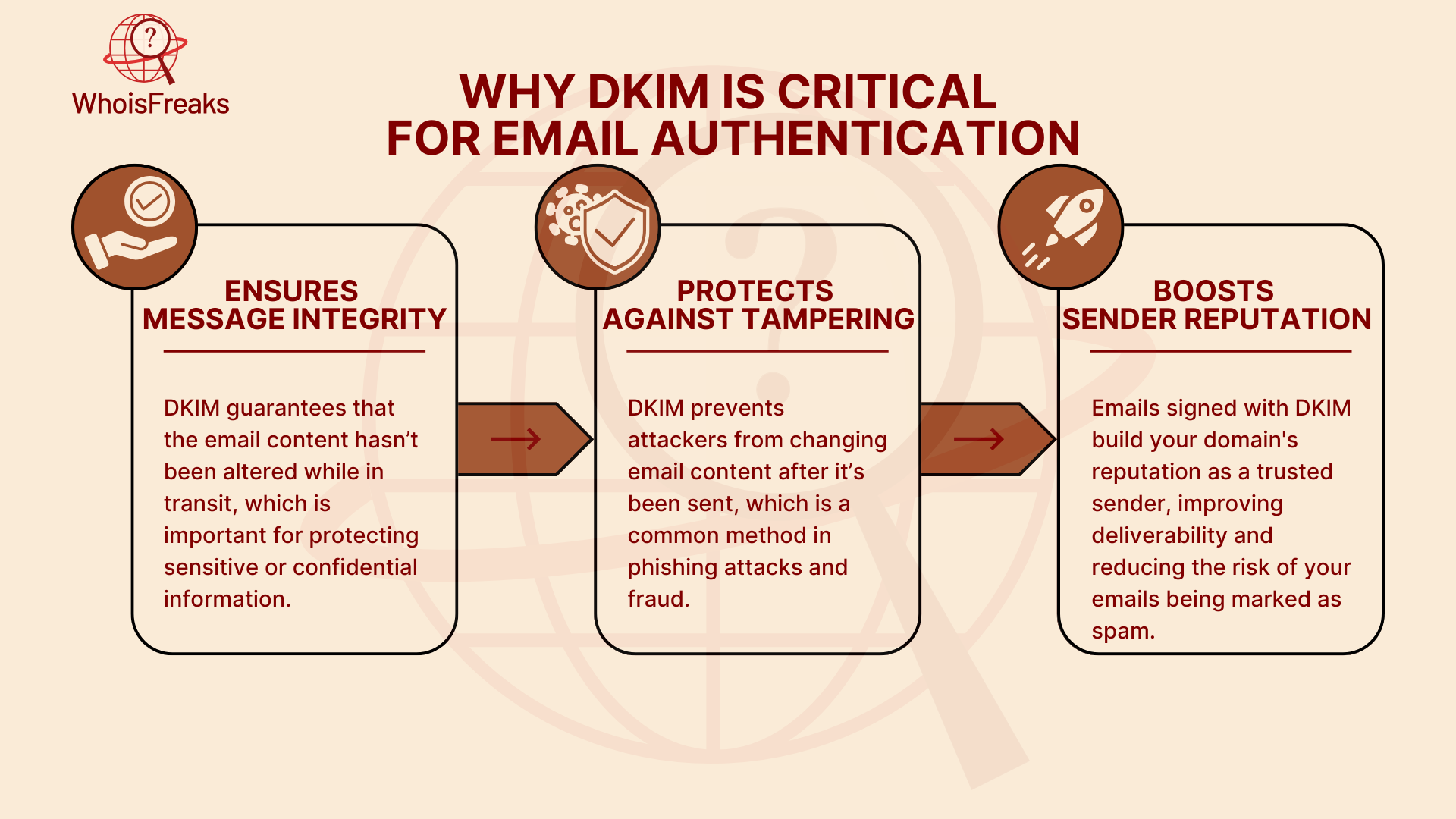
- Ensures Message Integrity: DKIM guarantees that the email content hasn’t been altered while in transit, which is important for protecting sensitive or confidential information.
- Protects Against Tampering: DKIM prevents attackers from changing email content after it’s been sent, which is a common method in phishing attacks and fraud.
- Boosts Sender Reputation: Emails signed with DKIM build your domain's reputation as a trusted sender, improving deliverability and reducing the risk of your emails being marked as spam.
DMARC (Domain-based Message Authentication, Reporting & Conformance): Enforcing Policies
DMARC is the third and final piece of the email authentication trio. While SPF and DKIM verify the legitimacy of the sending server and the integrity of the email message, DMARC ties these two protocols together and provides domain owners with a policy to dictate how to handle unauthenticated emails. By implementing DMARC, domain owners can enforce email authentication policies, ensure email security, and improve their overall email deliverability.
What is DMARC?
DMARC is the final piece of the email authentication puzzle. While SPF and DKIM verify the sender’s server and the integrity of the email, DMARC combines both and lets domain owners set policies on how to handle unauthenticated emails. By implementing DMARC, domain owners can enforce authentication policies, improve email security, and enhance email deliverability.
How DMARC Works
- Setting the DMARC Policy: The domain owner publishes a DMARC record in DNS, defining the policy (None, Quarantine, or Reject) and reporting preferences.
- Sending the Email: When an email is sent, the receiving server checks both SPF and DKIM records for authentication.
- DMARC Check: If the email fails the SPF or DKIM check (or both), the DMARC policy dictates how the receiving server should handle the email (e.g., quarantine or reject it).
- Reporting: If reporting is enabled, the receiving server sends a DMARC report to the domain owner. This includes data on which emails passed or failed authentication, helping the owner identify unauthorized senders and improve security.
Why DMARC is Essential for Comprehensive Email Security
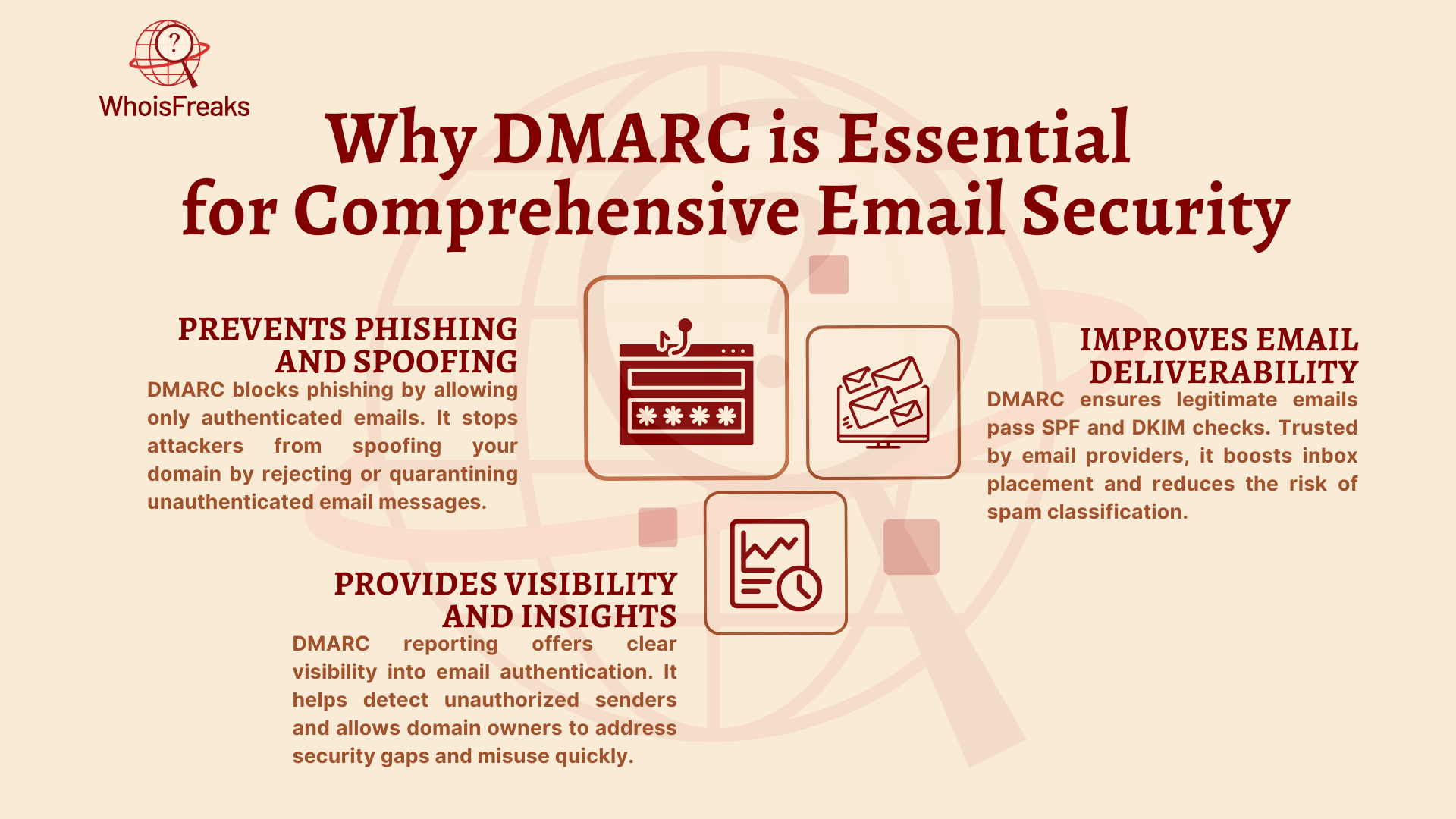
- Prevents Phishing and Spoofing: DMARC protects against phishing and spoofing by ensuring only authenticated emails are delivered. It prevents malicious actors from impersonating your domain by rejecting or quarantining unauthenticated emails.
- Provides Visibility and Insights: DMARC reports give domain owners visibility into email authentication activity, helping them detect unauthorized use of their domain and address security issues promptly.
- Improves Email Deliverability: DMARC enhances email deliverability by ensuring that legitimate emails pass both SPF and DKIM checks. Since email providers trust DMARC for authentication, emails from your domain are more likely to reach inboxes instead of being marked as spam.
Comparison Table: SPF, DKIM, and DMARC
To provide a clearer understanding of how SPF, DKIM, and DMARC work together to secure email communication, here’s a comparison table that highlights the key differences and benefits of each protocol:
| Feature | SPF (Sender Policy Framework) | DKIM (DomainKeys Identified Mail) | DMARC (Domain-based Message Authentication, Reporting & Conformance) |
|---|---|---|---|
| Purpose | Verifies the sending mail server | Ensures the integrity of the email message | Combines SPF and DKIM to enforce authentication and reporting |
| Mechanism | Checks if the sender's IP address matches authorized IPs in DNS | Uses a digital signature to verify the email’s integrity and authenticity | Uses SPF and DKIM results to enforce policies and send reports |
| DNS Records | SPF record in DNS | DKIM public key in DNS | DMARC policy in DNS |
| Primary Benefit | Prevents email spoofing at the sender’s server level | Confirms that the email content hasn’t been altered during transit | Provides a policy for handling unauthenticated emails and sends reports |
| Common Use | Prevents unauthorized servers from sending email on behalf of the domain | Ensures the authenticity and integrity of the email content | Protects the domain from phishing and spoofing while improving deliverability |
| Action on Failure | Fails the check if the IP doesn’t match the domain's SPF record | Fails if the digital signature doesn’t match the public key in DNS | Can quarantine, reject, or report emails that fail authentication checks |
How to Set Up SPF, DKIM, and DMARC: A Step-by-Step Guide
Setting up SPF, DKIM, and DMARC helps secure your domain’s email and improves deliverability. Here's how to set them up:
Setting Up SPF Records
- Log in to DNS: Access your DNS hosting provider (e.g., GoDaddy, Cloudflare).
- Create SPF Record: Add or update a TXT record with the following format:
v=spf1 ip4:<Authorized_IPs> include:<Third_Party_Services> ~all
- Verify SPF: Use an SPF checker (e.g., MXToolbox) to ensure the record is correct.
Configuring DKIM
- Generate Keys: Use your email provider or DKIM generator to create a public/private key pair.
- Publish Public Key: Add the public key to your DNS records as a TXT record:
default._domainkey.yourdomain.com IN TXT "v=DKIM1; k=rsa; p=<Your_Public_Key>"
- Sign Emails: Configure your mail server to sign outgoing emails with the private key.
- Verify DKIM: Use a DKIM checker to ensure your emails are signed correctly.
Implementing DMARC
- Create DMARC Record: Add a TXT record with this format:
_dmarc.yourdomain.com IN TXT "v=DMARC1; p=none; rua=mailto:dmarc-reports@yourdomain.com; ruf=mailto:dmarc-reports@yourdomain.com; pct=100"
- p=none: Start with this policy to monitor results before applying stricter policies like quarantine or reject.
- Monitor Reports: Review DMARC reports for email authentication performance.
- Adjust Policy: Based on reports, shift to stricter policies (quarantine, reject) for enhanced security.
The Role of DNS Records in Email Security
DNS records are crucial for the operation of email authentication protocols like SPF, DKIM, and DMARC. These DNS txt record ensure that only legitimate emails are delivered and help protect your domain from email spoofing and phishing attacks. By configuring the correct DNS records, you can ensure that your email system is secure and trustworthy.
Key DNS records like TXT, MX, and CNAME play an essential role in email security. These records define the rules for SPF, DKIM, and DMARC in your domain's DNS settings, making sure that emails are properly authenticated and delivered to the intended recipient. TXT records are used to store SPF and DMARC data, MX records determine which mail servers handle email for your domain, and CNAME records are used for DKIM public key lookups in DNS.
Accurate DNS configuration is essential to ensure email authentication functions correctly. Proper configuration helps protect against spoofing, improves email deliverability, and provides visibility into the authentication process. Mistakes in DNS records can lead to email delivery failures, such as legitimate emails being flagged as spam or even rejected outright. To maintain email security, it is important to regularly update your DNS records and monitor them for errors. Monitoring tools can help you detect issues with your authentication records. Additionally, implementing DNSSEC (Domain Name System Security Extensions) enhances security by protecting your DNS records from tampering and unauthorized changes.
Email Spoofing and How to Prevent It with SPF, DKIM, and DMARC
Email spoofing happens when attackers send emails that look like they come from a trusted source, but they’re actually from a different, fake server. This is often used for phishing attacks, tricking people into giving away sensitive information like passwords or credit card numbers. Spoofing can also damage your brand’s reputation and make people distrust your emails.
SPF, DKIM, and DMARC help stop spoofing:
- SPF makes sure that only authorized mail servers can send emails for your domain. If the server isn’t listed, the email is flagged as suspicious.
- DKIM adds a digital signature to emails, which proves that the content hasn’t been changed while on its way. If the signature doesn’t match, the email is marked as potentially fake.
- DMARC combines SPF and DKIM, telling receiving mail servers what to do with emails that fail these checks (whether to reject, quarantine, or allow them). It also provides reports to help you spot and fix problems.
Improving Email Deliverability with SPF, DKIM, and DMARC
Email deliverability is the ability of your emails to reach the recipient’s inbox instead of getting sent to the spam folder or rejected. Poor deliverability can hurt communication, whether you're sending marketing emails, transaction updates, or personal messages. Factors like sender reputation, spam filters, and being blacklisted can affect deliverability.
SPF, DKIM, and DMARC improve email deliverability from the sender's domain:
- SPF checks that your emails are sent from authorized servers, which helps prevent them from being flagged as spam.
- DKIM ensures the email content hasn’t been changed, which builds trust with email providers and increases the chances of your email landing in the inbox.
- DMARC works with SPF and DKIM to make sure only authenticated emails are accepted. It also provides reports, so you can see if any emails are causing problems.
By using SPF, DKIM, and DMARC, you can protect your emails from spoofing and improve the chances that your real emails will pass authentication checks and reach their destination safely.
Conclusion
Securing your email communication is more important than ever. With the increasing threats of email spoofing, phishing, and other cyberattacks, protocols like SPF, DKIM, and DMARC provide essential layers of protection to safeguard your domain and improve email deliverability. By understanding and correctly implementing these protocols, you can ensure that your emails are authenticated, trusted, and secure.
Implementing SPF, DKIM, and DMARC not only protects your domain from impersonation but also improves the trustworthiness of your email communication. These protocols verify that the emails you send are from legitimate sources, ensure that email content remains untampered with during transit, and help protect your reputation. More importantly, they provide an effective defense against phishing and spoofing attacks, which can have devastating effects on your business and personal security.
As you move forward with securing your email systems, the next steps are crucial. Begin by implementing email authentication setting up SPF, DKIM, and DMARC for your domain. Start with configuring your SPF records to specify authorized mail servers, then proceed with DKIM to sign your emails for integrity verification and finally implement DMARC to enforce policies on how your emails are handled by receiving servers. By following these steps, you’ll enhance your email security and significantly reduce the chances of unauthorized actors exploiting your domain.
To ensure the ongoing success of your email security strategy, regularly monitor your SPF, DKIM, and DMARC records, analyze reports, and adjust your configurations as needed. Over time, as you gain confidence in your email authentication method setup, you can move to stricter DMARC policies for enhanced protection. Implementing these measures may take some time and effort, but the long-term benefits of a secure, trustworthy email environment are invaluable for your business or personal communication.
FAQs
1. What is SPF, DKIM, and DMARC in email?
SPF, DKIM, and DMARC are email security protocols that verify if emails are legitimate and not from spoofed or fraudulent sources.
2. How do I authenticate emails received with SPF, DKIM, and DMARC alignment?
To authenticate emails, check that the email passes SPF and DKIM checks, and ensure that both align with the domain in the DMARC record.
3. What is the difference between DKIM and SPF email?
SPF checks if the sending server is authorized, while DKIM ensures the email's content hasn’t been altered during transit.
4. What protocol uses SPF and DKIM to help stop spam email?
DMARC uses SPF and DKIM to help stop spam by enforcing policies on how to handle unauthenticated emails.

Software Engineer
A software engineer focused on developing scalable, efficient solutions. Expertise in coding, system optimization, and utilizing advanced technologies for high-performance apps.
Related Posts

Understanding DNS Poisoning: Risks and Prevention ...
Discover essential insights on DNS poisoning and learn practical steps to safeguard your online presence. Read the article for vital protection tips.
Published at: Nov 7, 2025

Defending Against DNS Flood Attacks: Leveraging Wh...
Learn how a DNS flooder can threaten your network security and discover practical measures to protect your systems. Read more to safeguard your networ...
Published at: Oct 27, 2025

What is the Purpose of DNS Server? Understanding I...
Discover the essential role of DNS servers in internet functionality and learn how they enhance your online experience. Read the article for insights.
Published at: Oct 24, 2025

5 DNS Misconfigurations That Could Be Damaging You...
Discover 5 common DNS misconfigurations that can harm your email reputation. Ensure your emails land in inboxes, not spam. Read the article for soluti...
Published at: Jun 3, 2025